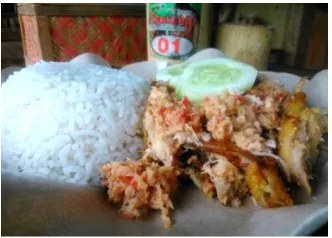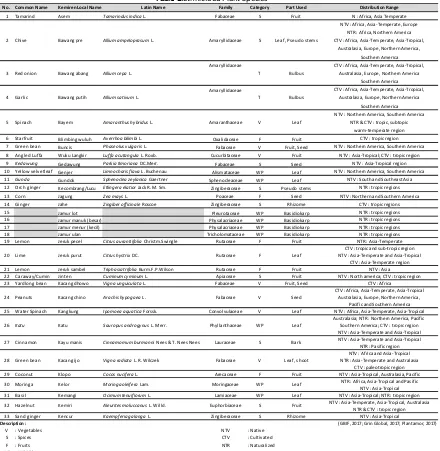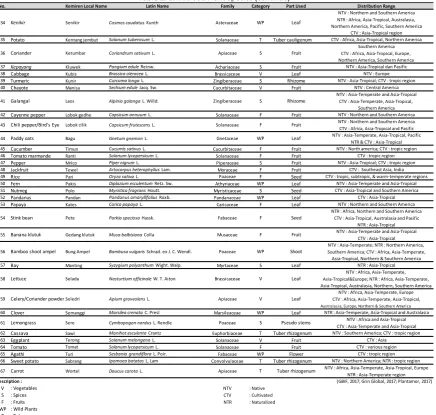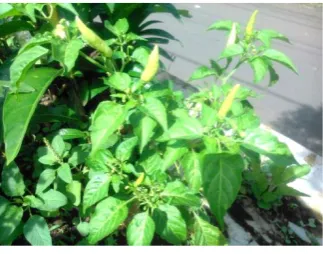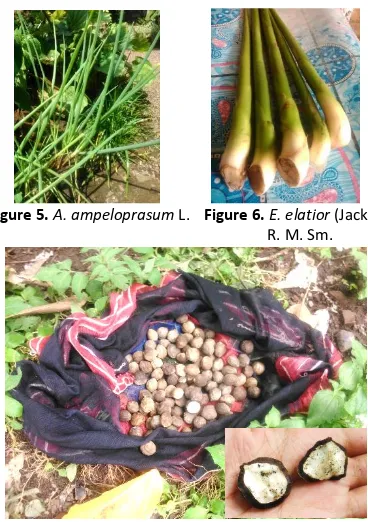Plants Diversity for Ethnic Food and the Potentiality of Ethno-culinary
Tourism Development in Kemiren Village, Banyuwangi, Indonesia
Wahyu Kusumayanti Putri
1*, Luchman Hakim
2, Serafinah Indriyani
21Master Program of Biology, Faculty of Mathematic and Natural Sciences, University of Brawijaya, Malang, Indonesia
2Department of Biology, Faculty of Mathematic and Natural Sciences, University of Brawijaya, Malang, Indonesia
Abstract
Recent rapid grow of culinary tourism has significant potential contribution to enhancing biodiversity conservation especially biodiversity of local plant species for local food and food preparation tradition in local community. Ethnic food has been explored as one of the indigenous resources for community-based tourism, in which it is important in community development and biodiversity conservation. The aim of the study was to describe the involvement of plant in local cuisine and the concept of culinary tourism products development. The research was based on ethno-botanical study through observation and interviews with local community and tourism stakeholder in Kemiren Village, Banyuwangi. This study found that there was 108 ethnic food menu in Kemiren Village. There are 67 species of 35 plant family were used in local cuisine. Kemiren Village has been identified rich in term of traditional culinary which are able to be developed as attractive cuisine in culinary tourism.
Keywords: culinary tourism,ethnicfood, Kemiren Village.
INTRODUCTION*
Special interest tourism recently grows significantly, and many developing countries with abundance nature and culture are the favorite destination for special interest tourism. Special interest tourism has been identified important to provides jobs, increase nation income from export, spread of business development and infrastructure [1,2].
Culinary tourism is the important sub-segment of special tourism in Indonesia. The richness of culture and food preparation in Indonesia are the potential sources for future tourism development, especially in culinary tourism sector. Besides its economic prospect, the development of local culinary tourism is importance to ensure the existence of local biodiversity as a materials for local cuisine. Presenting and promoting local culinary therefore important and relevant with the recent biodiversity conservation [3,4].
Osingnese in Kemiren Village, Banyuwangi, is one of the indigenous community in East Java (Indonesia) with its long preserved tradition and culture, including community habits in food preparation and food culture. For the development of tourism in Banyuwangi Regency, the unique and richness of traditional food in Kemiren Village can become basic research for
*Correspondence address:
Wahyu Kusumayanti Putri
Email : wahyu2ndsq@gmail.com
Address: Dept. Biology, University of Brawijaya, Veteran 65145, Malang
culinary tourism. The development of culinary tourism sector in Banyuwangi relevant with the recent trend of tourism development in Banyuwangi Regency. Recently, Banyuwangi Regency has been identified as one of the fastest rapid growing area in tourism sector [5,6].
As far, there is few studies regarding the plant species diversity as a component for local cuisine. This aspect becomes limitation aspect for further culinary tourism development, including conservation programs of plant which are an important in local cuisine [7]. There are also limitation program for tourism product development related to the local cuisine. It is especially important for many developing countries with rich in term of biodiversity and cuisine to develop more competitive culinary tourism based on local culture richness [8].This study aims to describe the diversity of plants which involved on the traditional food menu and the concept of tourist products for culinary tourism.
RESEARCH METHOD Study area
Kemiren Village located at Glagah Sub-regency, Banyuwangi Regency. Geographically, coordinate point of Kemiren Village is 8°12'12.7"S 114°19'14.6"E, an area 2.50 km2,
Figure 1. Study Site in Kemiren Village, Banyuwangi. Source: Google Maps, 2016
Methods
The data of plants/herbs which involved in ethnicfood menu in Kemiren obtained through observation, informal and semi structural interviews. Prior to the field survey, an intensive communication with village leaders and document study related to the villages history, social-cultural life were done systematically with the objectives generated information regarding focus of the study. Informants were chosen using purposive sampling technique and snowball methods. The local and traditional menu was listed and plant composition to make cuisine were recorded. The concept of tourists products especially culinary obtained by Focus Group Discussionwith informant keyfrom Kemiren village leader, local persons who are often invited as public chef cooking in village, and expert from
East Java Ecotourism Forum community. Data as
analyzed descriptively. The ethnobotany values of The Family Use Values (FUVs) was calculated using following formula :
𝐹𝑈𝑉 =
∑ 𝐹𝑈
𝑛
𝑖Description:
Ui = Amount of plant function that mentioned by respondents for each family
n = Amounts of respondents
RESULT AND DISCUSSION The Ethnicfood of Kemiren
There are about local 108 menus was stated by informant, indicated the community in Kemiren Village has numerous menu to consume in daily life. About 95 menus were reported native to Kemiren Village (Table 1). Informant argues that such menu has been consumed for a long time in the history of Osingnese in Kemiren Village .Informant report that some menu is the special menu among community member, including pecel pitik (Fig.2). This menu often made and presented in events and cultural activities. Many menu should be made and presented in cultural events of the villages.
Table 1.Ethnicfood Plant Species
Plants and Herbs in Ethnic food
The involvement plants on each menu will give it original taste which can be used as typical sense of each ethnic food menu aside from its beneficial to health. The plants that involved in menus (Table 1) divided into 5 types such as vegetables, spices, fruits, wild plants and tubers. Each menu consist of different plants composition. Some notable species was described below. The distribution list can be seen (Table 1).
Spice and herbs is an important material for many cuisine in the world. It tropical countries, it is often rich in term of spice an herb [9,10]. The cuisine of Osingnese in Kemiren Village basically rich in term of spice and herbs. This produce the
unique and specific menu which are important in culinary tourism development.
Based on the FUVs (Family Use Values) calculation, five families with the highest FUVs values (Fig. 3) among others Solanaceae, Amaryllidaceae, Zingiberaceae, Fabaceae, dan Euphorbiaceae. The first highest family with the highest FUVs value is Solanaceae family. Species that role in contributing to the highest value is Capsicum frutescens (chili pepper) (Fig. 4). The Kemiren community called it lobok cilik. Chili pepper contains fat, protein, carbohydrate, calcium, phosphorus, iron, vitamin A, B1, B2, C and alkaloid compounds [11]. This plantis used as a mixture of cuisine and treatment ingredients [12].
No. Common Name Kemiren Local Name Latin Name Family Category Part Used Distribution Range
1 Tamarind Asem Tamarindus indica L. Fabaceae S Fruit N : Africa, Asia Temperate NTV : Africa, Asia-Temperate, Europe
NTR : Africa, Northern America CTV : Africa, Asia-Temperate, Asia-Tropical,
Australasia, Europe, Northern America, Southern America Amaryllidaceae CTV : Africa, Asia-Temperate, Asia-Tropical,
Australasia, Europe, Northern America Southern America Amaryllidaceae CTV : Africa, Asia-Temperate, Asia-Tropical,
Australasia, Europe, Northern America Southern America NTV : Northern America, Southern America
NTR & CTV : tropic, subtopic warm-temperate region
6 Starfruit Blimbing wuluh Averrhoa bilimbi L. Oxalidaceae F Fruit CTV : tropic region
7 Green bean Buncis Phaseolus vulgaris L. Fabaceae V Fruit, Seed NTV : Northern America, Southern America
8 Angled Luffa Wuku Langkir Luffa acutangula L. Roxb. Cucurbitaceae V Fruit NTV : Asia-Tropical; CTV : tropic region
9 Kedawung Gedawung Parkia timoriana DC.Merr. Fabaceae S Seed NTV : Asia-Tropical region
10 Yellow velvetleaf Genjer Limnocharis flava L. Buchenau Alismataceae WP Leaf NTV : Northern America, Southern America
11 Gunda Gundok Sphenoclea zeylanica Gaertner Sphenocleaceae WP Leaf NTV : South and Southeast Asia
12 Orch ginger Kecombrang/Lucu Etlingera elatior Jack R. M. Sm. Zingiberaceae S Pseudo stems NTR : tropic regions
13 Corn Jagung Zea mays L. Poaceae F Seed NTV : Northern and Southern America
14 Ginger Jahe Zingiber officinale Roscoe Zingiberaceae S Rhizome CTV : tropic regions
15 Jamur lot Pleurotaceae WP Basidiokarp NTR : tropic regions 16 Jamur manuk (besar) Physalacriaceae WP Basidiokarp NTR : tropic regions 17 Jamur menur (kecil) Physalacriaceae WP Basidiokarp NTR : tropic regions 18 Jamur ulan Tricholomataceae WP Basidiokarp NTR : tropic regions
19 Lemon Jeruk pecel Citrus aurantiifolia Christm.Swingle Rutaceae F Fruit NTR : Asia-Temperate
CTV : tropic and sub-tropic region 20 NTV : Asia-Temperate and Asia-Tropical
CTV : Asia-Temperate region
21 Lemon Jeruk sambel Triphasia trifolia Burm.F.P.Wilson Rutaceae F Fruit NTV : Asia
22 Caraway/Cumin Jinten Cuminum cyminum L. Apiaceae S Fruit NTV : North america; CTV : tropic region
23 Yardlong bean Kacang dhowo Vigna unguiculata L. Fabaceae V Fruit, Seed CTV : Africa
CTV : Africa, Asia-Temperate, Asia-Tropical Australasia, Europe, Northern America,
Pacific and Southern America
25 Water Spinach Kangkung Ipomoea aquatica Forssk. Convolvulaceae V Leaf NTV : Africa, Asia-Temperate, Asia-Tropical
Australasia; NTR : Northern America, Pacific Southern America; CTV : tropic region NTV : Asia-Temperate and Asia-Tropical NTV : Asia-Temperate and Asia-Tropical
NTR : Pasific region NTV : Africa and Asia-Tropical NTR : Asia-Temperate and Australasia
CTV : paleotropic region
29 Coconut Klopo Cocos nucifera L. Arecaceae F Fruit NTV : Asia-Tropical, Australasia, Pacific
NTR : Africa, Asia-Tropical and Pasific NTV : Asia-Tropical
31 Basil Kemangi Ocimum tenuiflorum L. Lamiaceae WP Leaf NTV : Asia-Tropical; NTR : tropic region
NTV : Asia-Temperate, Asia-Tropical, Australasia NTR & CTV : tropic region
33 Sand ginger Kencur Kaempferia galanga L. Zingiberaceae S Rhizome NTV : Asia-Tropical
Description : (GBIF, 2017; Grin Global, 2017; Plantamor, 2017)
V : Vegetables NTV : Native
S : Spices CTV : Cultivated
F : Fruits NTR : Naturalized
WP : Wild Plants
Lime Jeruk purut Citrus hystrix DC.
2 Bawang pre Allium ampeloprasum L. Amaryllidaceae
Amaranthus hybridus L.
Arachis hypogaea L. Fabaceae Kacang chino
24
Sauropus androgynus L. Merr. Phyllanthaceae Katu
26 Katu
Lauraceae
Cinnamomum burmanni Nees & T. Nees Nees Kayu manis
27
28 Green bean Kacang ijo Vigna radiata L. R. Wilczek Fabaceae
30 Kelor Moringa oleifera Lam. Moringaceae
Table 1. Ethnicfood Plant Species (continue)
The next species are C. annuum(cayenne pepper), S. lycopersicum (tomato marmande), S. melongena (eggplant), S. lycopersicum (tomato), which is the fruit of the plant used as a food ingredient. The last species is S. tuberosum. Cayenne pepper contains capsaicin, vitamin C, beta-carotene, calcium, andphosphorus, and useful for relieving flu and nasal congestion [13]. The second family with the highest score of FUVs is Amaryllidaceae family. Species that role in contributing to the highest value is A. sativum (garlic). The species is utilized tuber by Kemiren Village community. Garlic contains 33 sulfur compounds, 17 amino acids, enzymes, minerals for example selenium [14]. Sulfur compounds cause a pungent smell of garlic andcontain many effects when used as a medicine [15]. Allicin compounds in garlic (chopped and exposed to room temperature) have antimicrobial effects to
combat viral, bacterial, fungal and parasitic attacks [16].
The next species is A. cepa (red onion), which is also used as a plant spice crop, and A. ampeloprasum (chive) (Fig. 5) by utilizing leaves. Redonion is a drug that can cherished civilization, because it has a very strong antioxidant content, fructans, flavonoids and organosulfur compounds, which is beneficial to human health as anti-carcinogenic, inflammatory, antiseptic, antipasmodic, carminative, diuretic, expectorant, febrifuge, hypoglemic, cholesterol, and anti biotic [17]. Chive is a plant that is consumed daily which is used as a complement to cooking, and has efficacy as a traditional medicine to treat inflammation and digestive problems [18]. This plant in the ethnobotany world acts as an antihelmintic, diuretic, antihypertensive and digestive [19,20].
No. Kemiren Local Name Latin Name Family Category Part Used Distribution Range
NTV : Northern and Southern America NTR : Africa, Asia-Tropical, Australasia, Northern America, Pacific, Southern America
CTV : Asia-Tropical region 35 Potato Kentang jembut Solanum tuberosum L. Solanaceae T Tuber cauligenum CTV : Africa, Asia-Tropical, Northern America
Southern America CTV : Africa, Asia-Tropical, Europe, Northern America, Southern America 37 Kepayang Kluwek Pangium edule Reinw. Achariaceae S Fruit NTV : Asia-Tropical dan Pasific 38 Cabbage Kubis Brassica oleracea L. Brassicaceae V Leaf NTV : Europe 39 Turmeric Kunir Curcuma longa L. Zingiberaceae S Rhizome NTV : Asia-Tropical; CTV : tropic region 40 Chayote Manisa Sechium edule Jacq. Sw. Cucurbitaceae V Fruit NTV : Central America
NTV : Asia-Temperate and Asia-Tropical CTV : Asia-Temperate, Asia-Tropical,
Southern America 42 Cayenne pepper Lobok gedhe Capsicum annuum L. Solanaceae F Fruit NTV : Northern and Southern America
NTV : Northern and Southern America CTV : Africa, Asia-Tropical and Pasific NTV : Asia-Temperate, Asia-Tropical, Pacific
NTR & CTV : Asia-Tropical 45 Cucumber Timun Cucumis sativus L. Cucurbitaceae F Fruit NTV : North america; CTV : tropic region 46 Tomato marmande Ranti Solanum lycopersicum L. Solanaceae F Fruit CTV : tropic region 47 Pepper Mrico Piper nigrum L. Piperaceae S Fruit NTV : Asia-Tropical; CTV : tropic region 48 Jackfruit Tewel Artocarpus heterophyllus Lam. Moraceae F Fruit CTV : Southeast Asia, India 49 Rice Pari Oryza sativa L. Poaceae F Seed CTV : tropic, subtropic, & warm-temperate regions 50 Fern Pakis Diplazium esculentum Retz. Sw. Athyriaceae WP Leaf NTV : Asia-Temperate and Asia-Tropical 51 Nutmeg Polo Myristica fragrans Houtt. Myristicaceae S Seed CTV : Asia-Tropical and Southern America 52 Pandanus Pandan Pandanus amaryllifolius Roxb. Pandanaceae WP Leaf CTV : Asia-Tropical 53 Papaya Kates Carica papaya L. Caricaceae F Leaf NTV : Northern and Southern America
NTR : Africa, Northern and Southern America CTV : Asia-Tropical, Australasia and Pasific
NTR : Asia-Tropical NTV : Asia-Temperate and Asia-Tropical
CTV : Asia-Tropical NTV : Asia-Temperate; NTR : Northern America, Southern America; CTV : Africa, Asia-Temperate, Asia-Tropical, Northern & Southern America 57 Bay Manting Syzygium polyanthum Wight. Walp. Myrtaceae S Leaf NTR : Asia-Tropical
NTV : Africa, Asia-Temperate, Asia-Tropical&Europe; NTR : Africa, Asia-Temperate, Asia-Tropical, Australasia, Northern, Southern America
NTV : Africa, Asia-Temperate, Europe CTV : Africa, Asia-Temperate, Asia-Tropical,
Australasia, Europe, Northern & Southern America
60 Clover Semanggi Marsilea crenata C. Presl Marsileaceae WP Leaf NTR : Asia-Temperate, Asia-Tropical and Australasia NTV : Africa and Asia-Tropical CTV : Asia-Temperate and Asia-Tropical 62 Cassava Sawi Manihot esculenta Crantz Euphorbiaceae T Tuber rhizogenum NTV : Southern America; CTV : tropic region 63 Eggplant Terong Solanum melongena L. Solanaceae V Fruit CTV : Asia
64 Tomato Tomat Solanum lycopersicum L. Solanaceae F Fruit CTV : various region 65 Agathi Turi Sesbaniagrandiflora L. Poir. Fabaceae WP Flower CTV : tropic region 66 Sweet potato Sabrang Ipomoea batatas L. Lam Convolvulaceae T Tuber rhizogenum NTV : Northern America; NTR : tropic region
NTV : Africa, Asia-Temperate, Asia-Tropical, Europe NTR : Asia-Temperate region
Description : (GBIF, 2017; Grin Global, 2017; Plantamor, 2017)
V : Vegetables NTV : Native S : Spices CTV : Cultivated F : Fruits NTR : Naturalized WP : Wild Plants
Kenikir Senikir Cosmos caudatus Kunth Asteraceae WP Leaf
34
Apiaceae
Coriandrum sativum L. Ketumbar
36 Coriander
41 Laos Alpinia galanga L. Willd. Zingiberaceae
43 Chili pepper/Bird's Eye Lobok cilik Capsicum frutescens L. Solanaceae Gnetaceae
55 Gedang klutuk Musa balbisiana Colla Musaceae
56 Bung Ampel Bambusa vulgaris Schrad. ex J. C. Wendl. Poaceae
Brassicaceae
Nasturtium officinale W. T. Aiton Selada
58
59 Seledri Apium graveolens L. Apiaceae
61 Sere Cymbopogon nardus L. Rendle Poaceae
Figure 3. The Family Use Values of Plant Resources which are Used in Traditional Menu
Figure 4. Capsicum frutescens L
The third highest family with the highest FUVs value is Zingiberaceae family
.
Species that role in contributing to the highest value is A. galanga (galangal), which the part used is rhizome. This plant contains essential oils and methanol fractions, which act as inhibition of microbialgrowth (anti microbial and fungi), so it can be used as a skin rub [21,22]. The next species is C. longa (turmeric), Z. officinale (ginger), E. elatior (orch ginger or wax flower) (Fig. 6), by utilizing the rhizome. The last species is K. galanga (sand ginger), by utilizing the rhizome. Turmeric contains antioxidant compounds that protect from the effects of free radicals, but it also serves as an anti-inflammatory, digestive, antibacterial, antimuta-genic, antifungi, antitertogenic, anti-tumor, anti carsinogenic and various diseases that attack humans [23]. In the history of drug use in China, ginger plays a role as antiemetic, antipyretic, and anti-inflammatory [24]. Orch ginger or wax flower is a natural insecticide and used as a mixture of pecel or lalapan cuisine. Stems, leaves, and rhizomes have chemical
17.472 11.717
11.019 7.189
6.151 5.415 4.528 4.075 2.925 2.585 2.302 2.019 1.132 1.132 1.113 1.019 0.943 0.887 0.849 0.849 0.830 0.736 0.434 0.415 0.358 0.340 0.189 0.132 0.132 0.094 0.075 0.075 0.038 0.038 0.038
0.000 2.000 4.000 6.000 8.000 10.000 12.000 14.000 16.000 18.000 20.000 Solanaceae
Amaryllidaceae Zingiberaceae Fabaceae Euphorbiaceae Poaceae Rutaceae Apiaceae
Arecacea Musaceae Cucurbitaceae Piperaceae Amaranthaceae Lamiaceae Myrtaceae Athyriaceae Brassicacea Myristicaceae Convolvulaceae Lauraceae Moringaceae Phyllanthaceae Gnetaceae Oxalidaceae Pandanaceae Moraceae Achariaceae Alismataceae Asteraceae Marsileaceae Physalacriaceae Sphenocleaceae Caricaceae Pleurotaceae Tricholomataceae
FUVs Value
F
ami
essential oils [25]. Sand ginger contains essential oils and ethyl p-methoxycinnamate, which serves to treat cough, stomachache and trigger the release of sweat [26, 27].
Figure 5. A. ampeloprasum L. Figure 6. E. elatior (Jack) R. M. Sm.
Figure 7. Seed of A. moluccanus L.
The fourth highest family with the highest FUVs value is Fabaceae family
.
Species that role in contributing to the highest value is A. hypogaea (peanuts), the part used is seed. And then V. unguiculata (yard long bean), which part used is fruit and leaves. The next species is P. vulgaris (green bean), P. timoriana (kedawung) by utilizing the seeds, T. indica (tamarind) by utilizing the fruit, V. radiata (green bean) by utilizing the seed sprouts, S. grandiflora (agathi) by utilizing the interest portion and P. speciosa (stink bean) by utilizing the seeds. Peanuts are protein-rich, cholesterol-free, contain highlevels of natural fiber, vitamins, and essential minerals, boost immunity, prevent cancer and heart attacks, reduce weight [28].Vigna unguiculata (yard long bean) contains 10 g of water; 22 g protein; 1.4 g of fat; 51 g of carbohydrate; 3.7 g vitamins; 3.7 g carbon; 104 mg of calcium and other nutrients. The resulting energy is about 1420 kj per 100 g at a measurement of 100g [29]. Yard long bean contain anthocyanin and glycine flavonoids [30]. Green bean play a role as antidiabetic, which can control the occurrence of hyperglycemic type 2
diabetes mellitus [31]. Leather stems, leaves, flowers and pods of this plant are used as traditional medicine or foodstuffs [32]. This plant has phytosterol content, which is dominated by beta-sitosterol [33]. Kedawung seeds are used to treat colic, a mixture of cholera drugs, seizures during menstruation, booster [34].
Tamarindus indica (tamarind) has a sour, sweet, cold taste, so many of these plant parts are used as traditional remedies to treat illness suffered by humans. Tamarind leaves are used to cure cough, jaundice, worm infections, ulcers, ulcers, and insomnia. The flower of this plant is used to treat bloody cough, rheumatism, edema, and external wounds. Fruit is used to cure constipation, dysentery, loss of appetite, vomiting, asthma, and inflammation of the breast. Seeds are used for snake bites, boils, and hair loss [34-37]. In Indonesia, asem used for traditional medicine will vary by region [38]. Green beanare beneficial for growth and cultivation because they contain carbohydrates, vitamin A, vitamin B, and minerals [39].
The fifth highest family with the highest FUVs value is Euphorbiaceae family. Species that role in contributing to the highest value is A. moluccanus (hazelnut) (Fig. 7), by utilizing the seeds. The next species is M. esculenta (cassava), which part used is tuber. Hazelnut seeds that have been extracted to produce oil, contain irritant substances functioning as laxative, soap replacement and hair care, and the remaining seeds can be used as fertilizer [40].
Culinary Tourism Product Development
Principally, culinary tourism is the tourism segment in which tourist searching and enjoying unique culinary in order to remember various types of menus throughout the journey [1,41]. Tourists tend to search for new things on the destination place, including culinary experience. From the discussion forum which are conducted to generate community and local tourist expertise in culinary development, the concept of tourism products that can be offered to Kemiren Village include:
1. Promoting an offering Osingnese culinary in every event in Banyuwangi Regency, and promotes the Osingnese culinary to the national and international tourist.
3. Developing coking class or other food making and preparation demonstration as part of the tourism program in Kemiren Village. It will be more interesting with expert assistance of Kemiren chef during process and accompanied by a guide who explain about relationship between local indigenous and Kemiren ethnicfood. This activity is special for tourists who want to know the making process of ethnicfood menus.
In order to enhance the role of culinary tourism in Kemiren, some aspect were recommended, including:
1. Training guide skill for youth or Kemiren community in order to provide assistance to tourists (explaining the unique of Kemiren local wisdom that can not be separated from the dish of ethnicfood menus)
2. Kemiren communities who are involved in the welcoming activities of foreign or local tourists better to always use traditional clothes of Kemiren.
3. Conducting tour promo through social media, print and electronic.
4. Kemiren Culinary can take a part in Culinary Festival Indonesia event.
CONCLUSION
Osingnese community in Kemiren Village has 108 traditional menus which area consume in daily life and presented in particular cultural event. The number of plan species which are used in local cuisine included 67 plant species from 35 families.The concept of tourism products should be developed on mechanism of tourist services by providing guides and culinary facilities based on local wisdom of Kemiren.
REFERENCES
[1] Long, L. M. (Ed). 2004. Culinary tourism. University Press of Kentucky. Lexington. [2] Wolf, E. 2006. Culinary tourism: The hidden
harvest: A dozen hot and fresh reasons how culinary tourism creates economic and community development. Kendall/Hunt. [3] Bessière, J. 1998. Local development and
heritage: traditional food and cuisine as tourist attractions in rural areas. Sociologia ruralis 38(1), 21-34.
[4] Sukenti, K., L. Hakim, S. Indriyani, Y. Pur-wanto and P. J. Matthews. 2016. Ethno-botanical study on local cuisine of the Sasak tribe in Lombok Island, Indonesia. Journal of Ethnic Foods 3(3), 189-200.
[5] Zakiyah, Z., S. Indriyani and L. Hakim. 2013. Pemetaan sebaran dan karakter populasi tanaman buah di sepanjang koridor jalur wisata desa Kemiren, Tamansuruh, dan Kampunganyar, Kabupaten Banyuwangi. Journal of Indonesian Tourism and Develop-ment Studies 1(2), 46-51.
[6] Setiawan, A., M. Jayani, N. Anissa, R. Oktavia, R. D. Triyani and M. M. Parto. 2016. The role of Banyuwangi Ethno Carnival 2015 for Event Tourism in Banyuwangi.
[7] Toledo, Á. and B. Burlingame. 2006. Bio-diversity and nutrition: A common path toward global food security and sustainable development. Journal of Food Composition and Analysis 19(6), 477-483.
[8] Jalis, M. H., D. Che and K. Markwell. 2014. Utilizing local cuisine to market Malaysia as a tourist destination. Procedia Social and Behavioral Sciences 144, 102-110.
[9] Rosengarten, Jr. F. 1969. The book of spices. Livingston Publishing Company Pennsylvania. [10]Small, E. 2006. Culinary herbs. NRC Research
Press.
[11]Rukmana, R. 2004. Usaha tani cabai rawit. Kanisius. Jakarta.
[12]Mubarokah, N., H. B. Setyawan and U. Sholikhah. 2015. Kadar capsaicin dua varietas cabai rawit (C. frutescens L.) sebagai respon pengaruh dosis pupuk nitrogen. Berkala Ilmiah PERTANIAN. Available at: http://repository.unej.ac.id/bitstream/handl e/123456789/71039/NAILUL%20MUBAROKA H.pdf;sequence=1.
[13]Utami, S. 2011. Manfaat kandungan zat dalam cabe (C. annum L) bagi kesehatan. Jurnal Kesehatan.
[14]Newall, C. A., L. A.Anderson and J. D. Phillipson 1996. Herbal medicines: a guide for health-care professionals. Pharmaceu-tical Press. London.
[15]Kathi, J. And M.D. Kemper. 2000. The Longwood herbal task force and the center for holistic pediatric education and research. Garlic (A. sativum). Available at: http://www.mcp.edu/herbal/default.htm. [16]Blania, G. and B. Spangenberg. 1991.
Formation of allicin from dried garlic (A.
sativum): a simple HPTLC method for
simultaneous determination of allicin and ajoene in dried garlic and garlic preparations. Planta Medica 57, 371-375.
Ethnomedicinal and therapeutic properties. Research Signpost 37/661(2), 27.
[18]Camila, R., P.Bernadete andP.José. 2011. A new steroidal saponin with antiinflammatory and antiulcerogenic properties from the bulbs of Allium ampeloprasum var. porrum. Fitoterapia 82, 1175-1180.
[19]Guarrera P. M. and V. Savo. 2013. Perceived health properties of wild and cultivated food plants in local and popular traditions of Italy: A review. Journal of Ethnopharmacology 146(3), 659-680.
[20]García-Herrera, P, P.Morales, V. Fernández-Ruiz, M. C. Sánchez-Mata, Cámara. 2014. Nutrients, phytochemicals and antioxidant activity in wild populations of A. ampelopra-sum L. , a valuable underutilized vegetable. Food Research International 62, 272-279. [21]Yuharmen, Y., Y. Eryanti and Nurbalatif.
2002. Uji aktivitas antimikrobia minyak atsiri dan ekstrak metanol lengkuas (A. galanga). Jurnal Nature Indonesia 4(2), 178-183. [22]Handajani, N.S. and T.Purwoko. 2008.
Aktivitas ekstrak rimpang lengkuas (A.
galanga) terhadap pertumbuhan jamur
Aspergillus spp. Penghasil aflatoksin dan F. moniliforme. Biodiversitas 9(3), 161-164. [23]Purba, E.R. and M.Martosupono. 2009.
Kurkumin sebagai senyawa antioksidan. Proceeding Seminar of National Science and Science Education IV(3), 607-621.
[24]Leung A. Y. 2007. Chinese herbal remedies. In: Chrubasik, J. E., B. D. Roufogalis and D. Chrubasik. Evidence of effectiveness of herbal anti-inflammatory drugs in the treatment of painful osteoarthritis and chronic low back pain. Phytotherapy Research 21, 675-683.
[25]Department of Health. 2007. INSIDE (Inspirasi dan Ide) Litbangkes P2B2 Vol II: Aedes aegyptivampir mini yang mematikan. Research and Development, Indonesian Department of Health. Jakarta.
[26]Afriastini. 1990. Daftar jenis nama tanaman. Penebar Swadaya. Jakarta.
[27]Hikmah, D. F., N. Chotimah, S. Rosidah, N. K. Sukarya and K. Wachidah. 2015. Lilin kencur (K. galanga L.) dengan variasi bentuk sebagai farmakoterapi. Available at: http://artikel. dikti.go.id/index.php/PKMK/article/downloa d/ 512/ 512.
[28]Research and Development of Agriculture. 2012. Kacang tanah. No. 3449. Available at: http://www.litbang.pertanian.go.id/downloa
d/one/302/file/KACANG-TANAH-SUMBER-PANGAN.pdf.
[29]Aswan, F. 2009. Pengaruh frekuensi penyiraman terhadap pertumbuhan dan hasil kacang tunggak (V. Unguiculata). Thesis. Faculty of Agriculture. Nusa CendanaUniversity. Kupang.
[30]Lattanzio, V., S. Arpaia, A. Cardinali, D. Di Venere and V. Linsalata. 2000. Role of endogenous flavonoids in resistance mechanism of Vignato Aphids. Journal of Agricultural Food and Chemistry 48(11), 5316-5320.
[31]Oktarlina, R. Z. and N. R. Rachmawani. 2017. Khasiat pemberian buncis (P. vulgaris L.) sebagai terapi alternatif diabetes melitus tipe 2. Majority 6(1), 71-76.
[32]Houe’rou, L. 2005. Parkia biglobosa (Jacq.) R. Br. ex G. Don. Available at: www.fao.org. [33]Tisnadjaja, D., S. L. Hidayat, S. Sumirja and P.
Simanjuntak. 2006. Pengkajian kandungan fitosterol pada tanaman kedawung (P. roxburgii G. Don). Biodiversitas 7(1), 21-24. [34]Heyne, K. 1987. Tumbuhan berguna
Indone-sia, Vol.II. Research and Development, Department of Forestry. Jakarta.
[35]Perry, L. M. 1980. Medicinal plants of East and Southeast Asia. The MIT Press. London. [36]Department of Health. 1993. Formularium
obat tradisonal Indonesia. Directorate General of Medicine and Food Monitoring. Jakarta.
[37]Dalimartha, S. 2006. Atlas tumbuhan Indone-sia, 4th Ed. Puspa Swara. Jakarta.
[38]Sangat, H. M., E. A. M. Zuhud, E. K. Damayanti. 2000. Kamus penyakit dan tumbuhan obat Indonesia (Etnofitofarmaka). Yayasan Obor. Jakarta.
[39]Maryam, S. 2015. Potensi tempe kacang hijau (V. Radiata L.) hasil fermentasi menggunakan inokulum tradisional sebagai pangan fungsional. Jurnal Sains dan Teknologi 4(2), 635-641.
[40]Elevitch, C.R. and H.I. Manner. 2006. Traditional tree initiative: species profiles for Pacific Islands agroforestry. Available at: http://www.agroforestry.net/tti/Aleurites-kukui.pdf.
